low beam CADILLAC SRX 2007 1.G Owners Manual
[x] Cancel search | Manufacturer: CADILLAC, Model Year: 2007, Model line: SRX, Model: CADILLAC SRX 2007 1.GPages: 522, PDF Size: 2.71 MB
Page 161 of 522
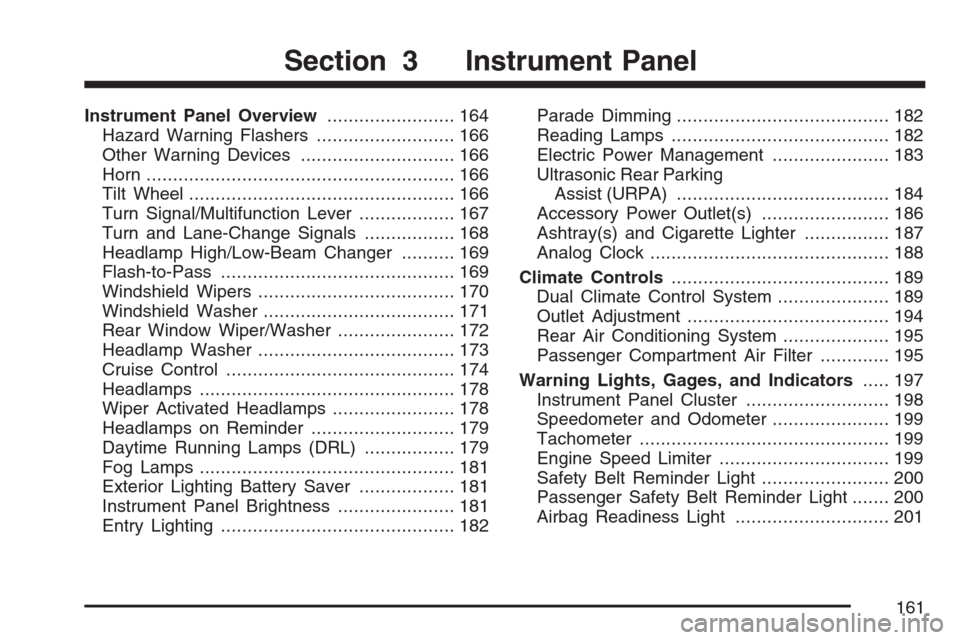
Instrument Panel Overview........................ 164
Hazard Warning Flashers.......................... 166
Other Warning Devices............................. 166
Horn.......................................................... 166
Tilt Wheel.................................................. 166
Turn Signal/Multifunction Lever.................. 167
Turn and Lane-Change Signals................. 168
Headlamp High/Low-Beam Changer.......... 169
Flash-to-Pass............................................ 169
Windshield Wipers..................................... 170
Windshield Washer.................................... 171
Rear Window Wiper/Washer...................... 172
Headlamp Washer..................................... 173
Cruise Control........................................... 174
Headlamps................................................ 178
Wiper Activated Headlamps....................... 178
Headlamps on Reminder........................... 179
Daytime Running Lamps (DRL)................. 179
Fog Lamps................................................ 181
Exterior Lighting Battery Saver.................. 181
Instrument Panel Brightness...................... 181
Entry Lighting............................................ 182Parade Dimming........................................ 182
Reading Lamps......................................... 182
Electric Power Management...................... 183
Ultrasonic Rear Parking
Assist (URPA)........................................ 184
Accessory Power Outlet(s)........................ 186
Ashtray(s) and Cigarette Lighter................ 187
Analog Clock............................................. 188
Climate Controls......................................... 189
Dual Climate Control System..................... 189
Outlet Adjustment...................................... 194
Rear Air Conditioning System.................... 195
Passenger Compartment Air Filter............. 195
Warning Lights, Gages, and Indicators..... 197
Instrument Panel Cluster........................... 198
Speedometer and Odometer...................... 199
Tachometer............................................... 199
Engine Speed Limiter................................ 199
Safety Belt Reminder Light........................ 200
Passenger Safety Belt Reminder Light....... 200
Airbag Readiness Light............................. 201
Section 3 Instrument Panel
161
Page 167 of 522
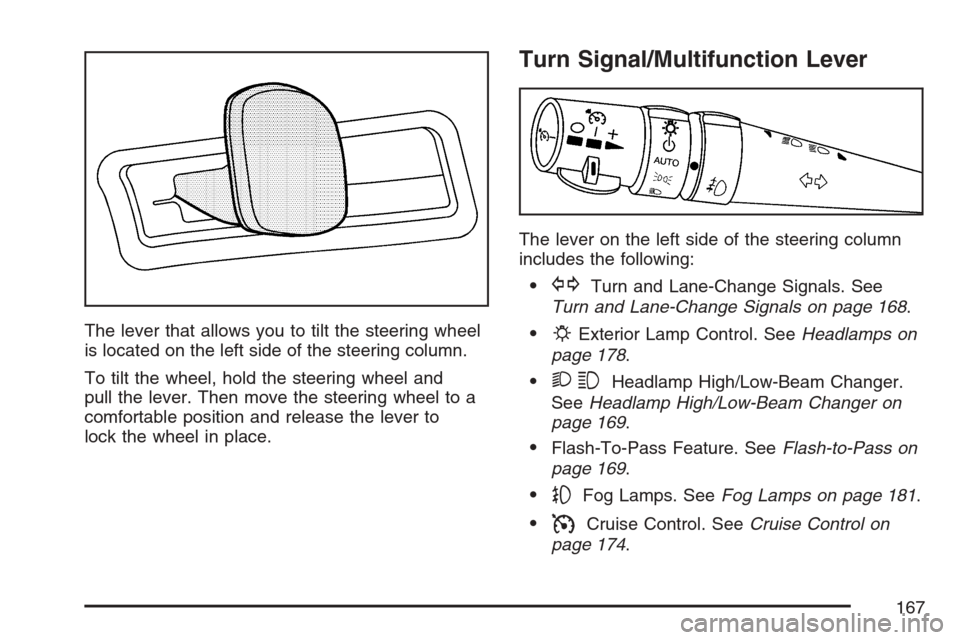
The lever that allows you to tilt the steering wheel
is located on the left side of the steering column.
To tilt the wheel, hold the steering wheel and
pull the lever. Then move the steering wheel to a
comfortable position and release the lever to
lock the wheel in place.
Turn Signal/Multifunction Lever
The lever on the left side of the steering column
includes the following:
GTurn and Lane-Change Signals. See
Turn and Lane-Change Signals on page 168.
PExterior Lamp Control. SeeHeadlamps on
page 178.
23Headlamp High/Low-Beam Changer.
SeeHeadlamp High/Low-Beam Changer on
page 169.
Flash-To-Pass Feature. SeeFlash-to-Pass on
page 169.
-Fog Lamps. SeeFog Lamps on page 181.
ICruise Control. SeeCruise Control on
page 174.
167
Page 169 of 522
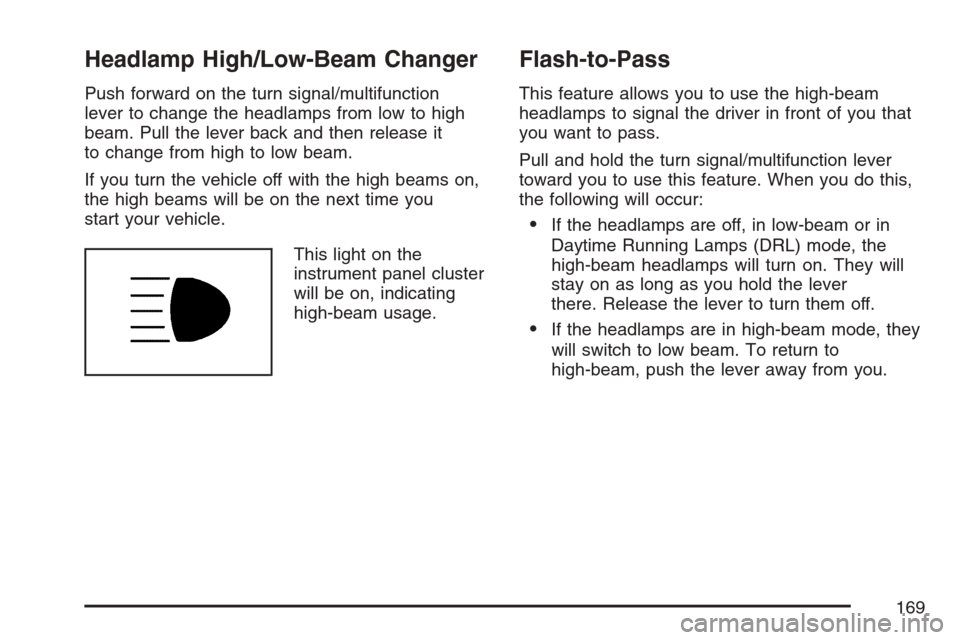
Headlamp High/Low-Beam Changer
Push forward on the turn signal/multifunction
lever to change the headlamps from low to high
beam. Pull the lever back and then release it
to change from high to low beam.
If you turn the vehicle off with the high beams on,
the high beams will be on the next time you
start your vehicle.
This light on the
instrument panel cluster
will be on, indicating
high-beam usage.
Flash-to-Pass
This feature allows you to use the high-beam
headlamps to signal the driver in front of you that
you want to pass.
Pull and hold the turn signal/multifunction lever
toward you to use this feature. When you do this,
the following will occur:
If the headlamps are off, in low-beam or in
Daytime Running Lamps (DRL) mode, the
high-beam headlamps will turn on. They will
stay on as long as you hold the lever
there. Release the lever to turn them off.
If the headlamps are in high-beam mode, they
will switch to low beam. To return to
high-beam, push the lever away from you.
169
Page 180 of 522
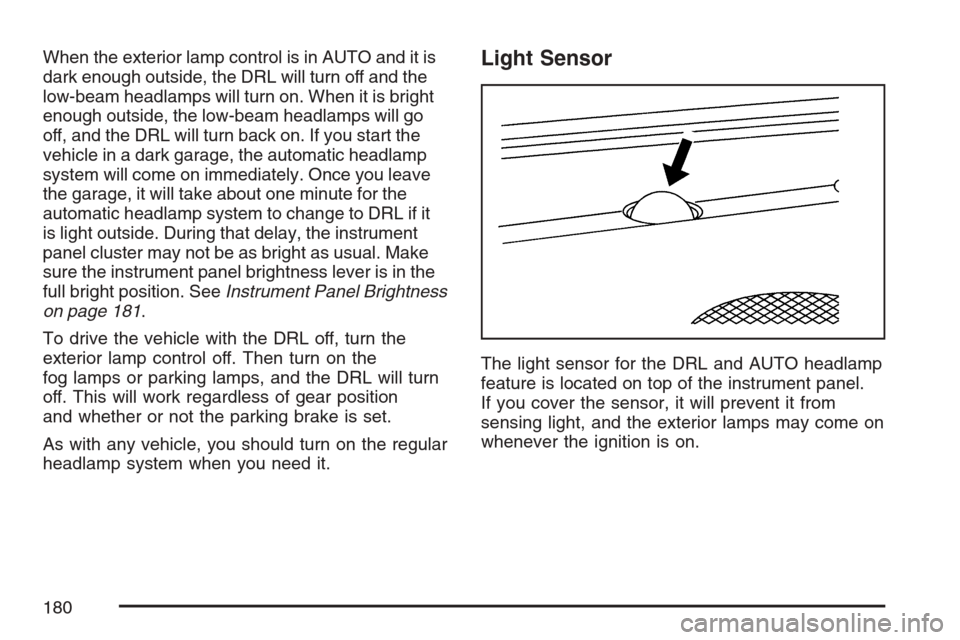
When the exterior lamp control is in AUTO and it is
dark enough outside, the DRL will turn off and the
low-beam headlamps will turn on. When it is bright
enough outside, the low-beam headlamps will go
off, and the DRL will turn back on. If you start the
vehicle in a dark garage, the automatic headlamp
system will come on immediately. Once you leave
the garage, it will take about one minute for the
automatic headlamp system to change to DRL if it
is light outside. During that delay, the instrument
panel cluster may not be as bright as usual. Make
sure the instrument panel brightness lever is in the
full bright position. SeeInstrument Panel Brightness
on page 181.
To drive the vehicle with the DRL off, turn the
exterior lamp control off. Then turn on the
fog lamps or parking lamps, and the DRL will turn
off. This will work regardless of gear position
and whether or not the parking brake is set.
As with any vehicle, you should turn on the regular
headlamp system when you need it.Light Sensor
The light sensor for the DRL and AUTO headlamp
feature is located on top of the instrument panel.
If you cover the sensor, it will prevent it from
sensing light, and the exterior lamps may come on
whenever the ignition is on.
180
Page 181 of 522

Fog Lamps
Use the fog lamps for better vision in foggy or
misty conditions.
The fog lamp controls are located on the turn
signal/multifunction lever.
-(Fog Lamps):The band with this symbol is
used to turn the fog lamps on and off.
The parking lamps must be on for the fog lamps
to work.
To turn the fog lamps on, turn the fog lamp band
on the lever up to the dot and release it. The
band will return to its original position.
To turn the fog lamps off, turn the fog lamp band
up to the dot and release it. The band will
return to its original position, and the fog lamps
will turn off. If the high-beam headlamps are turned
on, the fog lamps will also turn off. They will turn
back on again when you switch back to low-beam
headlamps.
Some localities have laws that require the
headlamps to be on along with the fog lamps.
Exterior Lighting Battery Saver
If the parking lamps or headlamps have been left
on, the exterior lamps will turn off about 10 minutes
after the ignition is turned to OFF. This protects
against draining the battery in case the headlamps
or parking lamps have been left on. The battery
saver does not work if the headlamps are turned on
after the ignition is turned to OFF.
If you need to leave the lamps on for more than
10 minutes, use the exterior lamp control to
turn the lamps back on.
Instrument Panel Brightness
Turn the knob clockwise
or counterclockwise to
brighten or dim the
interior lights.
To turn on the dome lamps, turn the knob
completely clockwise as far as it will go. The
dome lamps stay on until they are turned off.
181
Page 183 of 522
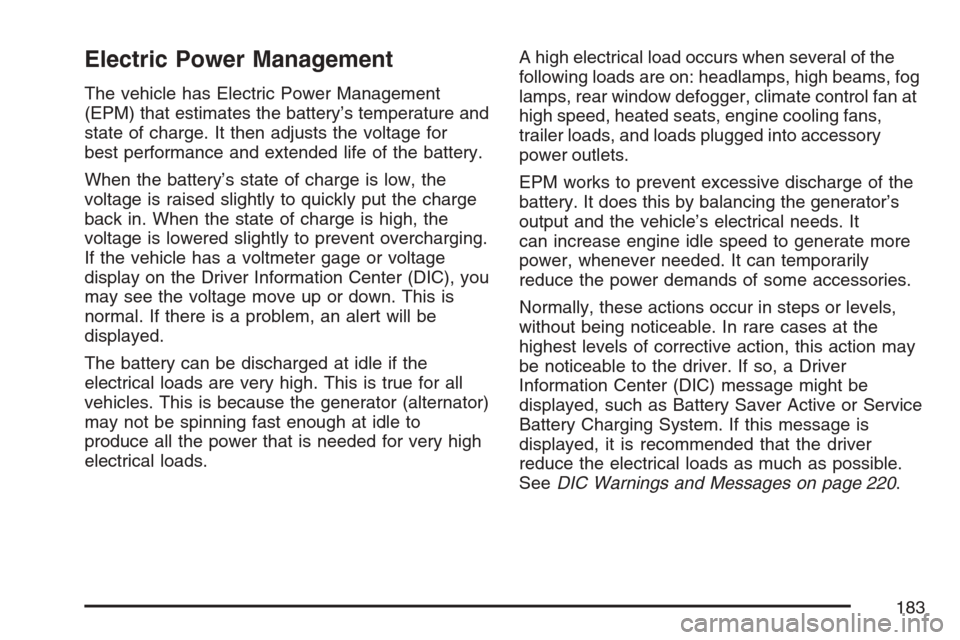
Electric Power Management
The vehicle has Electric Power Management
(EPM) that estimates the battery’s temperature and
state of charge. It then adjusts the voltage for
best performance and extended life of the battery.
When the battery’s state of charge is low, the
voltage is raised slightly to quickly put the charge
back in. When the state of charge is high, the
voltage is lowered slightly to prevent overcharging.
If the vehicle has a voltmeter gage or voltage
display on the Driver Information Center (DIC), you
may see the voltage move up or down. This is
normal. If there is a problem, an alert will be
displayed.
The battery can be discharged at idle if the
electrical loads are very high. This is true for all
vehicles. This is because the generator (alternator)
may not be spinning fast enough at idle to
produce all the power that is needed for very high
electrical loads.A high electrical load occurs when several of the
following loads are on: headlamps, high beams, fog
lamps, rear window defogger, climate control fan at
high speed, heated seats, engine cooling fans,
trailer loads, and loads plugged into accessory
power outlets.
EPM works to prevent excessive discharge of the
battery. It does this by balancing the generator’s
output and the vehicle’s electrical needs. It
can increase engine idle speed to generate more
power, whenever needed. It can temporarily
reduce the power demands of some accessories.
Normally, these actions occur in steps or levels,
without being noticeable. In rare cases at the
highest levels of corrective action, this action may
be noticeable to the driver. If so, a Driver
Information Center (DIC) message might be
displayed, such as Battery Saver Active or Service
Battery Charging System. If this message is
displayed, it is recommended that the driver
reduce the electrical loads as much as possible.
SeeDIC Warnings and Messages on page 220.
183
Page 213 of 522
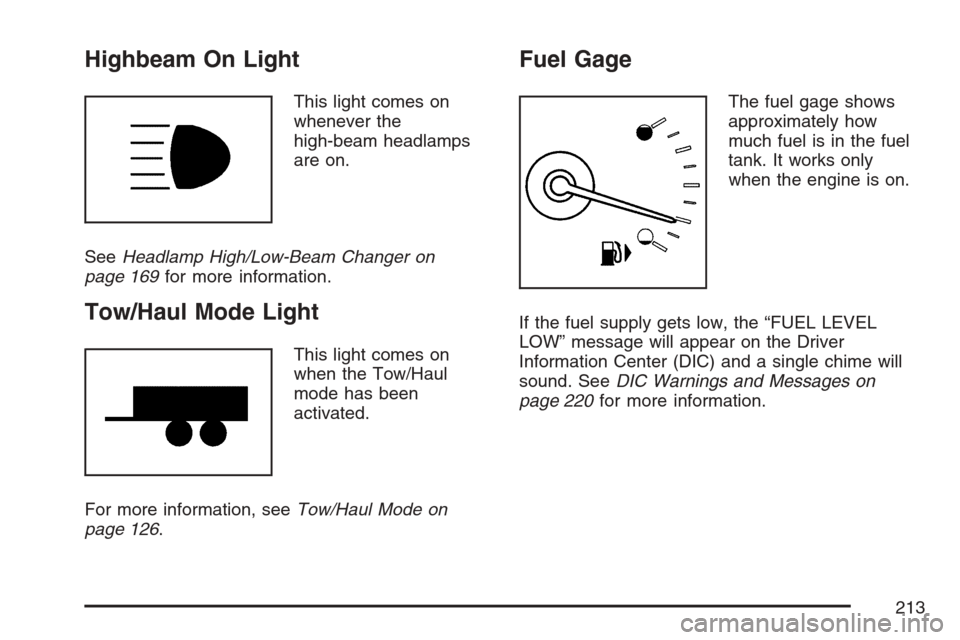
Highbeam On Light
This light comes on
whenever the
high-beam headlamps
are on.
SeeHeadlamp High/Low-Beam Changer on
page 169for more information.
Tow/Haul Mode Light
This light comes on
when the Tow/Haul
mode has been
activated.
For more information, seeTow/Haul Mode on
page 126.
Fuel Gage
The fuel gage shows
approximately how
much fuel is in the fuel
tank. It works only
when the engine is on.
If the fuel supply gets low, the “FUEL LEVEL
LOW” message will appear on the Driver
Information Center (DIC) and a single chime will
sound. SeeDIC Warnings and Messages on
page 220for more information.
213
Page 307 of 522

No one can see as well at night as in the daytime.
But as we get older these differences increase.
A 50-year-old driver may require at least twice as
much light to see the same thing at night as a
20-year-old.
What you do in the daytime can also affect your
night vision. For example, if you spend the
day in bright sunshine you are wise to wear
sunglasses. Your eyes will have less trouble
adjusting to night. But if you are driving, do not
wear sunglasses at night. They may cut down on
glare from headlamps, but they also make a
lot of things invisible.
You can be temporarily blinded by approaching
headlamps. It can take a second or two, or
even several seconds, for your eyes to re-adjust
to the dark. When you are faced with severe glare,
as from a driver who does not lower the high
beams, or a vehicle with misaimed headlamps,
slow down a little. Avoid staring directly into
the approaching headlamps.Keep the windshield and all the glass on your
vehicle clean — inside and out. Glare at night is
made much worse by dirt on the glass. Even
the inside of the glass can build up a �lm caused
by dust. Dirty glass makes lights dazzle and
�ash more than clean glass would, making the
pupils of your eyes contract repeatedly.
Remember that the headlamps light up far less of a
roadway when you are in a turn or curve. Keep your
eyes moving; that way, it is easier to pick out dimly
lighted objects. Just as the headlamps should be
checked regularly for proper aim, so should your
eyes be examined regularly. Some drivers suffer
from night blindness — the inability to see in dim
light — and are not even aware of it.
307
Page 310 of 522

Driving Through Flowing Water
{CAUTION:
Flowing or rushing water creates strong
forces. If you try to drive through �owing
water, as you might at a low water
crossing, your vehicle can be carried
away. As little as six inches of �owing
water can carry away a smaller vehicle. If
this happens, you and other vehicle
occupants could drown. Do not ignore
police warning signs, and otherwise be
very cautious about trying to drive
through �owing water.
Some Other Rainy Weather Tips
Turn on your low-beam headlamps — not just
your parking lamps — to help make you more
visible to others.
Besides slowing down, allow some extra
following distance. And be especially careful
when you pass another vehicle. Allow yourself
more clear room ahead, and be prepared to
have your view restricted by road spray.
Have good tires with proper tread depth. See
Tires on page 398.
310
Page 396 of 522

Bulb Replacement
It is recommended that all bulbs be replaced by
your dealer.
High Intensity Discharge (HID)
Lighting
{CAUTION:
The low beam high intensity discharge
lighting system operates at a very high
voltage. If you try to service any of the
system components, you could be
seriously injured. Have your dealer or a
quali�ed technician service them.Your vehicle has HID headlamps. After your
vehicle’s HID headlamp bulb has been replaced,
you may notice that the beam is a slightly different
shade than it was originally. This is normal.
Halogen Bulbs
{CAUTION:
Halogen bulbs have pressurized gas
inside and can burst if you drop or
scratch the bulb. You or others could be
injured. Be sure to read and follow the
instructions on the bulb package.
396